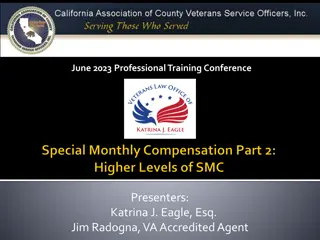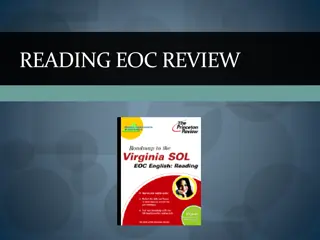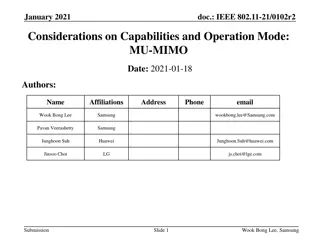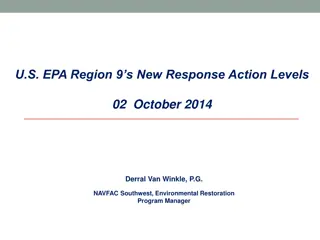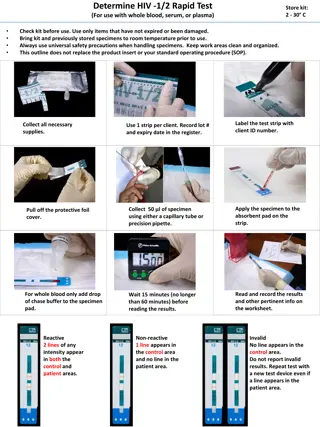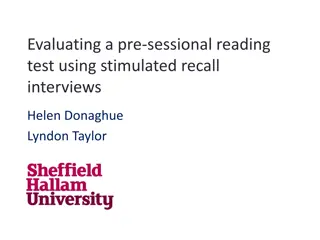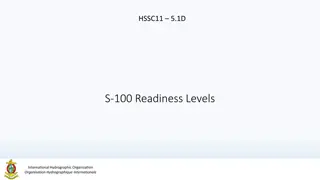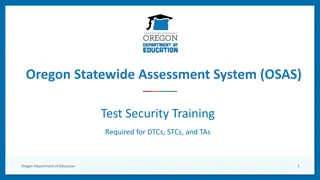
Software Testing Levels, Objectives, and Techniques
Explore the various software testing levels, their objectives, tools, and participants. Learn about unit/component testing, integration testing, and testing techniques like Test-Driven Development.
Download Presentation

Please find below an Image/Link to download the presentation.
The content on the website is provided AS IS for your information and personal use only. It may not be sold, licensed, or shared on other websites without obtaining consent from the author. If you encounter any issues during the download, it is possible that the publisher has removed the file from their server.
You are allowed to download the files provided on this website for personal or commercial use, subject to the condition that they are used lawfully. All files are the property of their respective owners.
The content on the website is provided AS IS for your information and personal use only. It may not be sold, licensed, or shared on other websites without obtaining consent from the author.
E N D
Presentation Transcript
Test Levels and Test Types Bal zs Cserp k ni.com
Test Levels ni.com
Test Phases or Levels Software testing levels are the different stages of the software development lifecycle where testing is conducted. What we are going to talk about Typical testing objectives for each level Test basis for each level Tools, environment for each level Test participants for each level
Component (Unit) Test Objective: Find Bugs, build confidence and reduce risk in the individual pieces of the system under test prior to system integration. Item Under Test (IUT): functions, classes or larger components Basis: Code, technical requirements Environment, tools: Development environment, drivers and stubs Responsible: Usually programmers, but level of proficiency and degree of execution varies.
Unit/Component Test Process Often, bugs are fixed upon being found without any reporting, which reduces the transparency of the development process with respect to quality Test-driven development (tests first, development next) Develop a set of unit tests Build and integrate code Run the test and debug until the test pass
Drivers and Stubs During unit, component, and integration testing it s often necessary to simulate parts of call flow reachable from module(s) under test Data setup sometimes necessary, also Driver: functions(s) that call module(s) under test Stub: function(s) calls directly or indirectly by module(s) under test
Integration Test Objective: find bugs, build confidence, and reduce risk in the relationships and interfaces between pairs and groups of components in the system under test as the pieces come together. Item Under Test: Two or more integrated components Basis: architecture, technical requirements, dataflows Environment, tools: Development environment, Test Environment, drivers and stubs Responsible: Ideally both testers and programmers
Integration Techniques I. Big bang Take all modules, put them together and test Quick, but where s the bug? Why wait until all code is written to start integration testing Bottom up Start with bottom layer modules; use appropriate drivers; test Repeat process; replacing drivers with modules; until done Good bug isolation but what if nasty bugs are at the top?
Integration Techniques II. Top down Like bottom up, but start from top and use stubs Good bug isolation but what if nasty bugs are at the bottom? Functional or Transactional Integrate set of components required to implement a single function or transaction Repeat process; replacing stubs and drivers with set of components to implement next function or transaction Good bug isolation, can find integration bugs in risk of order
System Test Objective: find bugs, build confidence and reduce risk in the overall particular behaviors, functions and responses of the system under test as a whole Item Under Test: Whole system in as realistic-as-possible test environment, including user and operator manuals and configuration data Basis: Business requirements, use cases, business/domain knowledge, common sense Environment, Tools: Test Environment, GUI Responsible: typically independent tester
Acceptance Test Objective: Demonstrate that the product is ready for deployment/release Item Under Test: Fully integrated system, including business, operational and maintenance processes, user procedures and configuration data Basis: Business, use cases, business/domain knowledge, common sense Environment and tools: GUI Responsible: Often users and customers but also independent tester.
Variations in Acceptance Testing User Acceptance testing: Business users verify fitness for functional purposes Alpha, Beta/field testing: Testing and confidence building by potential or existing customers. Beta testing and field testing are performed in the actual environment(s) Operational testing: Acceptance by system administrators (e.g., backup- restore, disaster recovery, user management, maintenance, data load/migration, security) Contract and regulation testing: Verification of conformance to contractually or legally mandated requirements, regulations or standards
Build-time vs. Run-time tests Build-time tests are run during the build process Unit/component tests, Integration tests Quick Done by developers Technical verification Always automated Run-time test are executed after the build (Software is ready for use) Unit/component tests, Integration tests, System tests Takes more time Done by testers Automated or manual
Test Types ni.com
Test Types Software Testing Type is a classification of different testing activities into categories, each having, a defined test objective, test strategy, and test deliverables
Test types Dynamic Static Black-box Static Analysis Review White-box Functional Non-functional Test types Change related Confirmation Regression
Static Testing Static testing is the testing of the software work products manually, or with a set of tools, but they are not executed. Static Analysis Using a tool to evaluate the Item Under Test Review Manual evaluation of the Item Under Test
Dynamic Test White-box Test or Structured-based testing In white-box testing the tester is concentrating on how the software does it. The internal structure of the software is known by the tester Black Box Testing or Specification-based testing In black-box testing the tester is concentrating on what the software does, not how it does it. The internal structure of the software is not known by the tester Third level Fourth level
Grey box testing We make assumptions about the internal structure of the software Requirement: Email field should validate if the entered value contains @ and give user a message if it doesn t Test: enter balazs.cserpak_gmail.com in Email field Expected result: User is notified that email address format is incorrect Why not test with: john.doe.at.gmail.com, jane.doegmail.com , donald.trump_gov.us etc.?
Black-box testing Functional testing Functional testing is a type of testing which verifies that each function of the software application operates in conformance with the requirement specification. What the system does Non-functional testing Non-functional testing is a type of testing to check non-functional aspects of a software application. It is explicitly designed to test the readiness of a system as per nonfunctional parameters which are never addressed by functional testing. How well the system does it
Non-functional Testing - Performance Testing Load testing - checks the application's ability to perform under anticipated user loads. The objective is to identify performance bottlenecks before the software application goes live. Stress testing - involves testing an application under extreme workloads to see how it handles high traffic or data processing. The objective is to identify the breaking point of an application. Endurance testing - is done to make sure the software can handle the expected load over a long period of time.
Non-functional Testing - Maintainability Testing It basically defines how easy it is to maintain the system, how easy it is to analyze, change and test the application or product. Update/patch install and uninstall processes don t work Configurations can t be changed appropriately Code not maintainable Software is not efficiently testable
Usability Testing In usability testing basically the testers tests the ease with which the user interfaces can be used. It tests that whether the application or the product built is user-friendly or not Learnability: How easy is it for users to accomplish basic tasks the first time they encounter the design? Efficiency: How fast can experienced users accomplish tasks? Memorability: When users return to the design after a period of not using it, does the user remember enough to use it effectively the next time, or does the user have to start over again learning everything? Errors: How many errors do users make, how severe are these errors and how easily can they recover from the errors? Satisfaction: How much does the user like using the system?
Portability Testing the ease with which a computer software component or application can be moved from one environment to another Hardware Operating system Browser
Other Non-functional testing types Disaster recovery Security Localization Data Quality And many others
Change related tests Confirmation Test Making sure that the changes applied successfully (bug fix or new functionality) Regression Test Making sure that the changes did not break existing functionality

